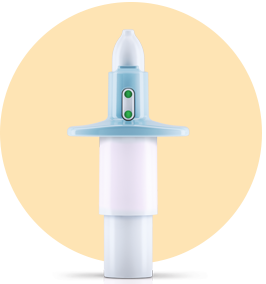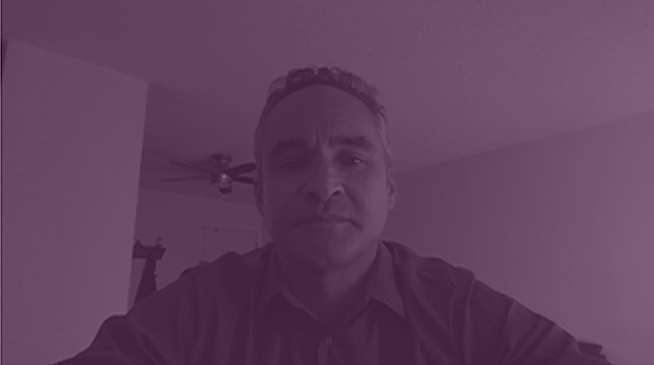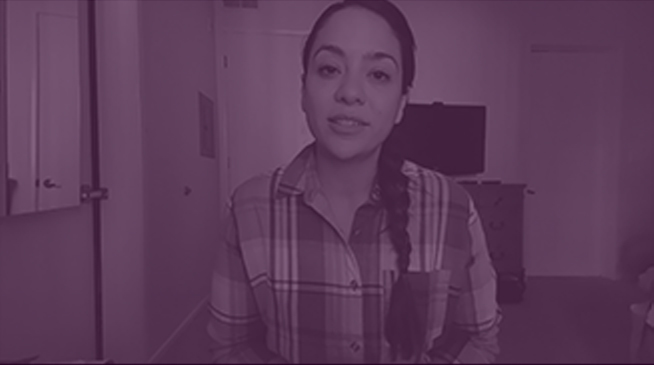Glutamate=the most abundant neurotransmitter (chemical messenger) in the brain.
Find a Treatment Center
Use this option to find a Treatment Center near you
Select any filter and click on Apply to see results
MDSI: Depressive symptoms in adults with major depressive disorder (MDD) with suicidal thoughts or actions.

SPRAVATO® offers a different approach and is the only nasal spray treatment indicated for treatment-resistant depression (TRD)

Glutamate=the most abundant neurotransmitter (chemical messenger) in the brain.
NMDA=N-methyl-D-aspartate.

Limitations of Use:
SPRAVATO® is not for use as a medicine to prevent or relieve pain (anesthetic). It is not known if SPRAVATO® is safe or effective as an anesthetic medicine.
It is not known if SPRAVATO® is safe and effective for use in preventing suicide or in reducing suicidal thoughts or actions. SPRAVATO® is not for use in place of hospitalization if your healthcare provider determines that hospitalization is needed, even if improvement is experienced after the first dose of SPRAVATO®.
It is not known if SPRAVATO® is safe and effective in children.
Tap a square to watch top doctors answer your top questions. Be sure to watch all the videos to get the full SPRAVATO® story, including safety information.
Tap a square to watch top doctors answer your top questions. Be sure to watch all the videos to get the full SPRAVATO® story, including safety information.

What is treatment-resistant depression?


What makes SPRAVATO® different from oral antidepressants?


What can I expect at my first treatment?


What might a treatment center look like?


What does SPRAVATO® treat? What are the side effects?


Why is there an observation period after taking SPRAVATO®?


How often will I take SPRAVATO®?


How soon might I see improvement with SPRAVATO®?


What success have you seen with SPRAVATO®?


What does SPRAVATO® treat? What are the side effects?

Watch this video on the
SPRAVATO® Important Safety Information

Question 1:
Speaker: I’ve heard of treatment-resistant depression, but what exactly is it?
Dr. Greg Mattingly: TRD, or treatment-resistant depression, refers to a group of patients who have not responded to two or more antidepressants.
SUPER: Treatment-Resistant Depression
SUPER: Healthcare providers may define the term “treatment-resistant depression” differently. Two or more oral antidepressants of adequate dose and duration in the current depressive episode.
Dr. Sandhya Prashad: Up to a third of patients will not achieve a significant response with oral antidepressants. So there’s definitely this huge unmet need.
SUPER: Be sure to watch all the Ask the Experts videos.
© Janssen Pharmaceuticals, Inc. 2021 04/21 cp-204334v1
Question 2:
Speaker: So I’m curious, what makes SPRAVATO® different from oral antidepressants?
Dr. Greg Mattingly: Up until now, our primary antidepressants have targeted the monoamines: serotonin, norepinephrine, dopamine. The problem is, about a third of people don’t respond to those types of treatment options.
Narrator: In a large-scale study, about one-third of patients with major depressive disorder did not respond to two or more oral antidepressants and may be considered to have treatment-resistant depression.
SUPER:
In a STAR*D trial1
About one-third of patients with major depressive disorder did not respond to two or more oral antidepressants and may be considered to have treatment-resistant depression
1. Rush AJ, et al. Acute and longer-term outcomes in depressed outpatients requiring one or several treatment steps: a STAR*D report. Am J Psychiatry. 2006;163(11):1905-1917.
SUPER: SPRAVATO® targets the N-methyl-D-aspartate (NMDA) receptor. The exact way that SPRAVATO® works is unknown.
Dr. Greg Mattingly: Now, with SPRAVATO®, we have a different treatment option.
SUPER: Be sure to watch all the Ask the Experts videos to get the full SPRAVATO® story, including safety information. Please see Important Safety Information, full Prescribing Information, including Boxed WARNINGS, and Medication Guide on this webpage.
© Janssen Pharmaceuticals, Inc. 2021 04/21 cp-204349v1
Question 3:
Speaker: What can I expect at my first treatment?
Dr. Sandhya Prashad: I try to have a lot of time for patients to ask questions, and to give them, even, material to look at, like the SPRAVATO® website, before they even start treatment.
SUPER: The first visit to the SPRAVATO® treatment center will be a consultation.
Dr. Sandhya Prashad: If it’s their first treatment, we bring them in, get their baseline blood pressure measurement and then we get them comfortable.
SUPER: Actor portrayal.
Dr. Sandhya Prashad: We get the trainer device, start going through what it would be like to self-administer SPRAVATO®.
"So, this isn’t the real medication, but I’d like you to practice with it."
Dr. Greg Mattingly: It has your assigned dose. You lean back, recommended around 45 degrees; you self-administer up one nostril, then the other; you wait five minutes to let it be absorbed.
SUPER: Actor portrayal.
SUPER: Do not eat at least two hours before, or drink liquids at least 30 minutes before taking SPRAVATO®, since some patients may experience nausea and vomiting. If you take nasal medications, take them at least one hour before taking SPRAVATO®.
Dr. Greg Mattingly: Forty minutes after dose, we’ll go back in and recheck blood pressure, recheck for any side effects and we’ll continue to do that then for the next two hours.
Narrator/SUPER: SPRAVATO® may cause a temporary increase in your blood pressure that may last for about four hours after taking a dose. Your healthcare provider will check your blood pressure before taking SPRAVATO® and for at least two hours after you take SPRAVATO®.
SUPER: Be sure to watch all the Ask the Experts videos to get the full SPRAVATO® story, including safety information. Please see Important Safety Information, full Prescribing Information, including Boxed WARNINGS, and Medication Guide on this webpage.
© Janssen Pharmaceuticals, Inc. 2021 04/21 cp-204346v1
Question 4:
Speaker: Can you show me what a SPRAVATO® treatment center might look like?
Dr. Greg Mattingly: In our office, we’ve taken a pretty simple approach. We have a quiet room, where a patient’s blood pressure can be monitored.
SUPER: Actor portrayal.
SUPER: Individual certified SPRAVATO® treatment centers may vary.
Dr. Greg Mattingly: We come and check on them periodically, and we watch them over two hours to make sure they’ve done well with the treatment.
SUPER: Patients are required to be monitored by a healthcare provider for at least two hours after taking SPRAVATO®.
Dr. Sandhya Prashad: We have a variety of treatment rooms at our treatment center. This is just one of them. We have equipment in here to monitor the patient’s blood pressure, a comfortable chair, things like blankets to be able to offer our patients. People can connect their phone and play music. We have the ability to adjust the lighting and a nurse call button in this room, so that if patients do need anything, they can call us.
SUPER: Be sure to watch all the Ask the Experts videos to get the full SPRAVATO® story, including safety information. Please see Important Safety Information, full Prescribing Information, including Boxed WARNINGS, and Medication Guide on this webpage.
© Janssen Pharmaceuticals, Inc. 2021 04/21 cp-204343v1
Question 5:
Speaker: So, is there any important safety information I should know about? Also, what does SPRAVATO® treat?
Dr. Greg Mattingly: After SPRAVATO® administration, some people do become a little bit detached, a little fuzzy; things seem brighter, or louder.
Narrator/SUPER: SPRAVATO® may cause sleepiness; feeling disconnected from yourself, your thoughts, feelings and things around you; dizziness; nausea; spinning sensation; or anxiety. If these common side effects occur, they usually happen right after taking SPRAVATO® and go away the same day.
Dr. Greg Mattingly: There’s a REMS Program that monitors how it’s given to make sure it’s done in a safe, consistent manner, and to also protect against any abuse or misuse of SPRAVATO® treatment.
SUPER: Risk Evaluation and Mitigation Strategy (REMS): Before starting SPRAVATO®, tell your healthcare provider if you have ever abused or been dependent on alcohol, prescription medicines or street drugs.
Dr. Greg Mattingly: Young adults, be careful with an increased risk of suicide, or suicidal behavior, with SPRAVATO® and/or any treatment option for depression.
SUPER: Antidepressants may cause an increased risk of suicidal thoughts and actions in some people aged 24 years and under.
Dr. Greg Mattingly: And it’s not a treatment for people that have certain complicated medical histories, such as aneurysms, intracranial hemorrhage, somebody with unstable blood pressure. I would not use SPRAVATO® in anyone who is pregnant or breastfeeding.
SUPER: Don’t take SPRAVATO® if you have a blood vessel disease, an abnormal connection between your veins and arteries, a history of bleeding in the brain or if you’re allergic to esketamine, ketamine or any of the ingredients in SPRAVATO®. Don’t take SPRAVATO® if you are pregnant, plan to become pregnant, or are breastfeeding.
Dr. Sandhya Prashad: SPRAVATO® is also not for use as an anesthetic, and it’s not approved for use in pediatric patients. So, at two hours, if they’re stable, their blood pressure is stable, and their mental status is pretty clear, then we let them go home with whoever it is that’s providing transportation for them. So SPRAVATO® is indicated for the treatment of treatment-resistant depression in adults when used in conjunction with an oral antidepressant.
SUPER: SPRAVATO® is not for use as a medicine to prevent or relieve pain (anesthetic). It is not known if SPRAVATO® is safe or effective as an anesthetic medicine. It is not known if SPRAVATO® is safe and effective in children. SPRAVATO® may cause a temporary increase in blood pressure that may last for about four hours after taking a dose. Your healthcare provider will check your blood pressure before taking SPRAVATO® and for at least two hours after. Tell your healthcare provider right away if you get chest pain, shortness of breath, sudden severe headache, change in vision or seizures after taking SPRAVATO®.
Narrator/SUPER: It is not known if SPRAVATO® is safe and effective for use in preventing suicide or in reducing suicidal thoughts or actions. SPRAVATO® is not for use in place of hospitalization, if your healthcare provider determines that hospitalization is needed, even if improvement is experienced after the first dose of SPRAVATO®.
SUPER: Actor portrayal.
SUPER: Be sure to watch all the Ask the Experts videos to get the full SPRAVATO® story, including safety information.
Narrator/SUPER: These are not all the side effects of SPRAVATO®. For the complete safety information, including a list of common side effects, please see the Important Safety Information video below and the SPRAVATO® Medication Guide on this webpage.
© Janssen Pharmaceuticals, Inc. 2021 04/21 cp-204345v1
Question 6:
Speaker: So why is there a two-hour observation period after taking SPRAVATO®?
Dr. Greg Mattingly: We watch our patients for two hours after they do the SPRAVATO® treatment. We look for side effects of sedation, dissociation, nausea, on top of watching blood pressure; and within about an hour and a half, you see that most patients’ vital signs, blood pressure, have gotten back to normal.
SUPER: SPRAVATO® may cause sleepiness (sedation), fainting, dizziness, spinning sensation, anxiety or dissociation (feeling disconnected from yourself, your thoughts, feelings and things around you). SPRAVATO® can cause a temporary increase in your blood pressure that may last for about 4 hours after taking a dose.
Dr. Greg Mattingly: They’re awake and alert; and at that two-hour mark, if all of those have gone back to normal, the patient is then allowed to leave the clinic with the caveat that they cannot drive themselves. No operating heavy equipment, machinery, things of that nature.
SUPER: Do not drive, operate machinery or perform any activities that require full alertness until the day after a treatment session, following a restful sleep.
Dr. Sandhya Prashad: Patients have to have a night of sleep before they drive again. I do talk to them about the fact that they might not be as sharp with their thinking, so they want to consider that with regards to any decision-making or work that they might try to do after the treatment.
SUPER: Be sure to watch all the Ask the Experts videos to get the full SPRAVATO® story, including safety information. Please see Important Safety Information, full Prescribing Information, including Boxed WARNINGS, and Medication Guide on this webpage.
© Janssen Pharmaceuticals, Inc. 2021 04/21 cp-204341v1
Question 7:
Speaker: So how often would I take SPRAVATO®? What’s the treatment schedule like?
Dr. Greg Mattingly: So when we break down treatment, the initial phase we call the Induction Phase.
SUPER:
Induction Phase in Treatment-Resistant Depression (TRD)
Weeks 1-4
SUPER: SPRAVATO® can only be self-administered at healthcare settings certified in the SPRAVATO® Risk Evaluation and Mitigation Strategy (REMS) Program.
Dr. Greg Mattingly: That will be two treatments per week for a total of four weeks. After the Induction Phase, which lasts for four weeks, you then go into the Maintenance Phase.
SUPER: At the end of the induction phase, your healthcare provider will evaluate your progress to determine the need for continued treatment.
SUPER:
Maintenance Phase in TRD
Weeks 5-8
Dr. Greg Mattingly: During the Maintenance Phase, you space the visits out. So instead of doing twice a week, you go to once a week.
SUPER:
Based on your doctor's clinical judgment
Weeks 9 and After
Dr. Greg Mattingly: After that, it’s really based on your doctor’s clinical judgment. You can space out the visits to once a week; you can space out the visits to every two weeks, depending on your response.
SUPER: Be sure to watch all the Ask the Experts videos to get the full SPRAVATO® story, including safety information. Please see Important Safety Information, full Prescribing Information, including Boxed WARNINGS, and Medication Guide on this webpage.
© Janssen Pharmaceuticals, Inc. 2021 04/21 cp-204336v1
Question 8:
Speaker: So how quickly might I see improvement with SPRAVATO®?
Dr. Sandhya Prashad: The thing we talk to patients about is that they’re not going to get one treatment and feel well immediately.
SUPER: Individual results may vary. Not everyone will respond to SPRAVATO®.
Dr. Sandhya Prashad: There’s a lot of enthusiasm when people come in looking for this treatment, and there’s a lot of hopefulness. You want to keep that hopefulness going. You want them to understand that it is a process and it’s going to take some time. So laying the groundwork, I think, is also very important and helpful.
Narrator/SUPER: Most common side effects include feeling disconnected from yourself, your thoughts, feelings and things around you; dizziness; nausea; feeling sleepy; spinning sensation; decreased feeling of sensitivity; feeling anxious; lack of energy; increased blood pressure; vomiting; feeling drunk; and feeling very happy or excited. If these common side effects occur, they usually happen right after taking SPRAVATO® and go away the same day.
SUPER: Be sure to watch all the Ask the Experts videos to get the full SPRAVATO® story, including safety information. Please see Important Safety Information, full Prescribing Information, including Boxed WARNINGS, and Medication Guide on this webpage.
© Janssen Pharmaceuticals, Inc. 2021 04/21 cp-204347v1
Question 9:
Speaker: Can you tell me what kind of success you’ve seen in your patients with SPRAVATO®?
Dr. Greg Mattingly: One of my patients who had been stuck in a bad depression, not for months, but for years; and now, to see him come in, smiling, talking about being with his kids, being with his wife. The day that we did our first SPRAVATO® treatment, I just kept thinking about all the patients that we’ve struggled with throughout the years, and how much help this might be for them.
Narrator/SUPER: In clinical studies, those who took SPRAVATO® plus an oral antidepressant experienced a greater reduction of depression symptoms at four weeks compared to those who took a placebo plus an oral antidepressant.
SUPER: Actor portrayal.
SUPER: Individual results may vary. Not everyone will respond to SPRAVATO®.
Dr. Sandhya Prashad: Patients that have been struggling for years, they actually get better. You will see a lot of patients responding. And it has really changed my interpretation of where patients can be.
Narrator/SUPER: Before taking SPRAVATO®, tell your healthcare provider about all of your medical conditions, including if you have: high blood pressure (hypertension); slow or fast heartbeats that cause shortness of breath, chest pain, lightheadedness or fainting; a history of heart attack or stroke; heart valve disease or heart failure; a history of brain injury or any condition where there is increased pressure in the brain; liver problems; or if you’ve ever had a condition called “psychosis.”
SUPER: Actor portrayal.
SUPER: Be sure to watch all the Ask the Experts videos to get the full SPRAVATO® story, including safety information. Please see Important Safety Information, full Prescribing Information, including Boxed WARNINGS, and Medication Guide on this webpage.
© Janssen Pharmaceuticals, Inc. 2021 04/21 cp-204350v1
IMPORTANT SAFETY INFORMATION
What is the most important information I should know about SPRAVATO®?
SPRAVATO® can cause serious side effects, including:
SPRAVATO® is not for use in children
Do not take SPRAVATO® if you:
If you are not sure if you have any of the above conditions, talk to your healthcare provider before taking SPRAVATO®.
Before you take SPRAVATO®, tell your healthcare provider about all of your medical conditions, including if you:
Tell your healthcare provider about all the medicines that you take, including prescription and over-the-counter medicines, vitamins and herbal supplements. Taking SPRAVATO® with certain medicine may cause side effects.
Especially tell your healthcare provider if you take central nervous system (CNS) depressants, psychostimulants, or monoamine oxidase inhibitors (MAOIs) medicines. Keep a list of them to show to your healthcare provider and pharmacist when you get a new medicine.
How will I take SPRAVATO®?
What should I avoid while taking SPRAVATO®?
Do not drive, operate machinery, or do anything where you need to be completely alert after taking SPRAVATO®. Do not take part in these activities until the next day following a restful sleep. See “What is the most important information I should know about SPRAVATO®?”
What are the possible side effects of SPRAVATO®?
SPRAVATO® may cause serious side effects including:
The most common side effects of SPRAVATO® when used along with an antidepressant taken by mouth include:
If these common side effects occur, they usually happen right after taking SPRAVATO® and go away the same day.
These are not all the possible side effects of SPRAVATO®.
Call your doctor for medical advice about side effects. You may report side effects to FDA at 1-800-FDA-1088.
Please see full Prescribing Information, including Boxed WARNINGS, and Medication Guide for SPRAVATO® at SPRAVATO.com and discuss any questions you may have with your healthcare provider.
cp-79822v3
© Janssen Pharmaceuticals, Inc. 2021 04/21 cp-220606v1
Learn More About SPRAVATO®

Studied in adults with treatment-resistant depression.*

Taken with an oral antidepressant.

In a long-term maintenance-of-effect trial,![]() patients who continued SPRAVATO®† treatment were less likely to experience a return of depressive symptoms (known as relapse) compared to those who stopped therapy.
patients who continued SPRAVATO®† treatment were less likely to experience a return of depressive symptoms (known as relapse) compared to those who stopped therapy.
The study was designed for patients in remission to see if the effect of treatment was maintained.

Nasal spray you self-administer under the supervision of a healthcare provider.

Greater reduction of depressive symptoms at four weeks‡ (compared to those who received a placebo and oral antidepressant).

Tell your healthcare provider if you have a history of drug or alcohol abuse.

After you take SPRAVATO®, a healthcare provider will monitor you for at least two hours during the observation period for possible serious side effects, including feeling sleepy (sedation or loss of consciousness), feeling disconnected from yourself, your thoughts, feelings and things around you (dissociation), breathing problems (respiratory depression and respiratory arrest) and increased blood pressure. More About Side Effects
*In clinical trials, treatment-resistant depression was diagnosed in adults who were struggling with major depressive disorder and had not responded adequately to at least two different antidepressants of adequate dose and duration in the current episode.
†Along with an oral antidepressant.
‡In clinical trials of adults who took SPRAVATO® and an oral antidepressant compared to those who received a placebo and an oral antidepressant. Based on an overall score on a standardized rating scale.
MDSI: Depressive symptoms in adults with major depressive disorder (MDD) with suicidal thoughts or actions.
